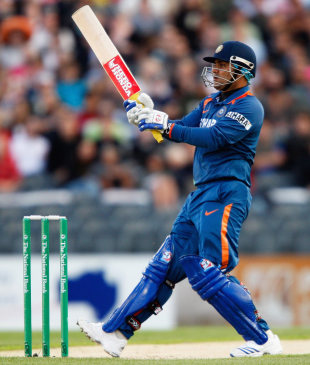Virender Sehwag
Ravi Shastri

|
|||
|
Related Links
|
|||
The Leading Cricketer in the World was instituted in Wisden 2004. The five previous winners have been Ricky Ponting, Shane Warne, Andrew Flintoff, Muttiah Muralitharan and Jacques Kallis. Players can be chosen more than once for this award.
Virender Sehwag had to beat off the strongest of challenges by Graeme Smith to become the Leading Cricketer in the World for 2008. Sehwag did so by taking the task of opening Test innings to a new level. He sought, and often achieved, mental domination from the first ball by scoring faster than any other opening batsman has ever done on a regular basis in Test cricket: 85 runs per 100 balls in the calendar year, without any soft opponents (Smith made 488 of his Test runs against Bangladesh); Sehwag also scored at 120 per 100 balls in one-day internationals.
He hit the fastest Test triple-century ever, from only 278 balls, against South Africa. Sehwag and India softened up Australia by defeating them 2-0 in India, for Smith and South Africa to beat them in Australia. Sehwag broke a mould as well as records: he set up the highest successful run-chase in Asia, and the fourth-highest to that point, by striking England's bowlers for 83 from 68 balls at Chennai. Smith was following Sehwag's suit when, a week later, he scored 108 in his second innings at Perth to set up the highest successful run-chase in Australia, and the second-highest ever.
It would be such a shame if Virender Sehwag needed to be buttressed with figures, hugely impressive as they are. They don't convey an iota of what the stocky figure of this Delhi dasher implies at the crease for bowlers. Fours and sixes come off his bat in rapid-fire succession, as if from a machine gun, and bowlers are out of their wits before long. A certain numbness overtakes them as they run up to bowl. And then there is mayhem.
Any coach of a rival team is at risk of slipping down in the eyes of his wards as soon as he floats a plan to curb Sehwag. In eight years and 66 Tests, there have been plans aplenty. Bowl him short-pitched deliveries - he doesn't have an on-side stroke except the thrust off his pads, and his straight drives aren't his strongest point. Don't give him room on his off stump, and tuck him up with big inswingers, are other suggestions. Yet nothing works. Sehwag somehow always creates room to free his arms. The overwhelming impression is that he wants every delivery to yield him a four or six.
Yet it would be folly to view Sehwag as no more than a rampaging bull in a cricketing arena. He is a masterful judge of a single, and it doesn't matter if the ball goes no more than a few feet away. He gets off the block quickly and has the confidence to take on the world's best. He isn't just a threat to those patrolling the boundaries; he is as much a menace to those who are marking the square. The opening pair of Sehwag and Gautam Gambhir are as exasperating with their running between wickets as with their inventive strokeplay.
Reputations don't matter to this most amazing of all modern cricketers, whose way of thinking is unlike any I have seen. He made a return to Test cricket in Perth at the start of 2008 and, despite being a borderline selection for the Australian tour and having been in hibernation for the best part of a year, he was as nonchalant as ever. Australia had packed their attack with four genuine fast bowlers on a track billed to be the WACA at its liveliest. No less a factor was the scorching hot and humid conditions. Sehwag's response? "Well, heat is welcome. It would mean the bowlers won't have long spells."
His mind is always working overtime on how to make bowlers lose their bearings. It was the same when, after almost two days in the field in the humidity of Chennai, he squared up to Dale Steyn, arguably the bowler of the year, and scored 319 off only 304 balls, judged by the ICC rankings as among the top ten Test innings of all time. Off his own bat Sehwag scored 257 runs on the third day, the most in modern times, against a high-class fielding side. Or when he smashed that double-hundred against Muttiah Muralitharan and freakish Ajantha Mendis, tipped to be the one who would redefine the art of spinning in years to come, and carried his bat for 201 out of India's total of 329 at Galle in July.
Sehwag is no mean off-spinner either, and has a five-for against Australia to prove it. Ego doesn't have any part in his mental make-up, and he rejoices as much in the success of a young mate as he applauds the milestones of a master like Sachin Tendulkar. He isn't the kind to hold grudges. And he only turned 30 in October 2008.
Sehwag is unorthodox, yet his batting skills vouch for the soundness of the time-tested art of batsmanship. Head completely still and movement of feet only once the ball is delivered. The only other player in the last decade who can be compared to him is Sanath Jayasuriya, but Sehwag is tighter and plays straighter, and hence is more consistent in all conditions, as shown by the fact that he has extended the last 11 of his 15 Test centuries to date past 150. His hand-eye co-ordination, grooved on the smooth concrete driveway beside the family home on the outskirts of Delhi, is freakish, and it allows him to predetermine his strokes. Virender Sehwag is a marvel of modern times, a genius who has confounded conventional wisdom, whose daring is now a part of cricket's folklore.

